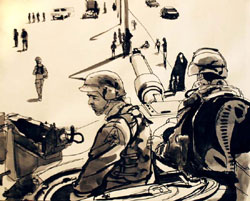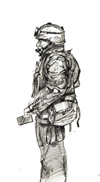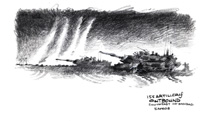Ralph Peters writes about his experience keeping track of combat in Iraq during the tumultuous month of April:
During the initial fighting in Fallujah, I tuned in al-Jazeera and the BBC. At the same time, I was getting insider reports from the battlefield, from a U.S. military source on the scene and through Kurdish intelligence. I saw two different battles.
Peters’ disenfranchisement with the media is hardly unique. Reports of the inadequacy of the media are legion. Eric M. Johnson is a U.S. Marine who served in Iraq and recently wrote about media bias:
Iraq veterans often say they are confused by American news coverage, because their experience differs so greatly from what journalists report. Soldiers and Marines point to the slow, steady progress in almost all areas of Iraqi life and wonder why they don’t get much notice – or in many cases, any notice at all.
Part of the explanation is Rajiv Chandrasekaran, the Baghdad bureau chief for the Washington Post. He spent most of his career on the metro and technology beats, and has only four years of foreign reporting, two of which are in Iraq. The 31-year-old now runs a news operation that can literally change the world, heading a bureau that is the source for much of the news out of Iraq.
… Chandrasekaran’s crew generates a relentlessly negative stream of articles from Iraq – and if there are no events to report, they resort to man-on-the-street interviews and cobble together a story from that.
It goes on from there, pointing out several examples and further evidence of the substandard performance of the media in Iraq. Then you have this infamous report from the Daily Telegraph’s correspondent Toby Harnden.
The other day, while taking a break by the Al-Hamra Hotel pool, fringed with the usual cast of tattooed defense contractors, I was accosted by an American magazine journalist of serious accomplishment and impeccable liberal credentials.
She had been disturbed by my argument that Iraqis were better off than they had been under Saddam and I was now – there was no choice about this – going to have to justify my bizarre and dangerous views. I’ll spare you most of the details because you know the script – no WMD, no ‘imminent threat'(though the point was to deal with Saddam before such a threat could emerge), a diversion from the hunt for bin Laden, enraging the Arab world. Etcetera.
But then she came to the point. Not only had she ‘known’ the Iraq war would fail but she considered it essential that it did so because this would ensure that the ‘evil’ George W. Bush would no longer be running her country. Her editors back on the East Coast were giggling, she said, over what a disaster Iraq had turned out to be. ‘Lots of us talk about how awful it would be if this worked out.’ Startled by her candour, I asked whether thousands more dead Iraqis would be a good thing.
She nodded and mumbled something about Bush needing to go. By this logic, I ventured, another September 11 on, say, September 11 would be perfect for pushing up John Kerry’s poll numbers. ‘Well, that’s different – that would be Americans,’ she said, haltingly. ‘I guess I’m a bit of an isolationist.’ That’s one way of putting it.
Yikes. I wish I knew a little more about this unnamed “magazine journalist of serious accomplishment and impeccable liberal credentials”, but it is a chilling admonition nonetheless.
Again, the inadequacy of the media has become painfully obvious over the past few years. How to deal with this? At a discussion forum the other day, someone posted this article concerning FOX News bias along with this breathless message:
This shouldn’t come as any surprise. How can a NEWS organization possibly be allowed to lie like this? FOX should be removed from the air and those who are in charge should be removed from the media business and not be allowed to do anything whatsoever where news and media are concerned.
they’re clearly out to deceive the American public.
Well, I suppose that is one way of dealing with media bias. But Ralph Peters’ response is drastically different. He assumes the media can’t or shouldn’t be changed. I tend to take his side, as arbitrarily removing a news organization from the air and blacklisting those in charge seems like a cure that is much worse than the disease to me, but that leads to some unpleasant consequences. Back to the Peters article:
The media is often referred to off-handedly as a strategic factor. But we still don’t fully appreciate its fatal power. Conditioned by the relative objectivity and ultimate respect for facts of the U.S. media, we fail to understand that, even in Europe, the media has become little more than a tool of propaganda.
That propaganda is increasingly, viciously, mindlessly anti-American. When our forces engage in tactical combat, dishonest media reporting immediately creates drag on the chain of command all the way up to the president.
Real atrocities aren’t required. Everything American soldiers do is portrayed as an atrocity. World opinion is outraged, no matter how judiciously we fight.
… The implication for tactical combat — war at the bayonet level — is clear: We must direct our doctrine, training, equipment, organization and plans toward winning low-level fights much faster. Before the global media can do what enemy forces cannot do and stop us short. We can still win the big campaigns. But we’re apt to lose thereafter, in the dirty end-game fights.
… Our military must rise to its responsibility to reduce the pressure on the National Command Authority — in essence, the president — by rapidly and effectively executing orders to root out enemy resistance or nests of terrorists.
To do so, we must develop the capabilities to fight within the “media cycle,” before journalists sympathetic to terrorists and murderers can twist the facts and portray us as the villains. Before the combat encounter is politicized globally. Before allied leaders panic. And before such reporting exacerbates bureaucratic rivalries within our own system.
[emphasis mine] This is bound to be a difficult process, and will take years to perfect. If we proceed on this path, we’ll have to suffer many short term problems, including a much higher casualty rate, perhaps for both sides (and even civilians). If we don’t proceed along this path; if we don’t learn to kill quickly, then we’ll lose slowly.
For it’s part, the military has shown some initiative in dealing with the media. Wretchard writes about a Washington Post article describing the victory that the First Armored Division won over Moqtada Al-Sadr’s militia:
In what was probably the most psychologically revealing moment of the battle, infantrymen fought six hours for the possession of one damaged Humvee, of no tactical value, simply so that the network news would not have the satisfaction of displaying the piece of junk in the hands of Sadr’s men.
… Ted Koppel was determined to read the names of 700 American servicemen who have died in Iraq to remind us how serious was their loss. Michael Moore has dedicated his film Farenheit 9/11 to the Americans who died in Afghanistan. And they did a land office business. But at least they didn’t get to show Sadr’s miliamen dancing around a battered Humvee. The men of the First Armored paid the price to stop that screening and those concerned can keep the change.
I don’t know that Peters’ pessimism is totally warranted, but there is an element of pragmatism involved that should be considered. It is certainly frustrating though.
***
It is noteworthy that media bias goes both ways. I tended to be conservative leaning in this post, but liberals have a lot to gripe about too. I’ve written about this before. Peters wrote that killing faster would help the situation, but that is from a military perspective. From our perspective, the only thing we can do is take the media with a grain of salt and do our best to point out their failures and herald their successes. It’s not easy, that is the price we must pay for freedom of speech. Hopefully more on this in a later post. [thanks to Donald Sensing for the Toby Harnden pointer]

 As 160,000 coalition troops stormed into Iraq last March, thirteen artists (some military, some civilian) were commissioned to depict coalition forces in action. WSJ.com (their
As 160,000 coalition troops stormed into Iraq last March, thirteen artists (some military, some civilian) were commissioned to depict coalition forces in action. WSJ.com (their  As
As